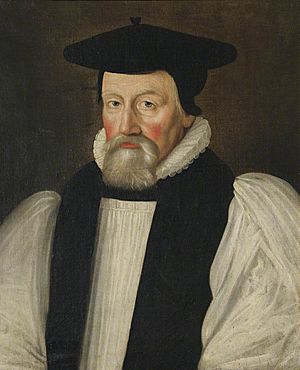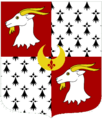Thomas Morton (bishop) facts for kids
Quick facts for kids The Right Reverend Thomas Morton |
|
|---|---|
| Bishop of Durham | |

Portrait by Simon Luttichuys
|
|
| Diocese | Diocese of Durham |
| In Office | 1632–1646 (Episcopacy abolished) |
| Predecessor | John Howson |
| Successor | Vacant (Civil War) |
| Other posts | Dean of Gloucester (June 1607–1609) Dean of Winchester (1609–1616) Bishop of Chester (1616–1619) Bishop of Lichfield & Coventry (February 1619–1632) |
| Orders | |
| Ordination | 1594 |
| Consecration | 1616 |
| Personal details | |
| Born | 20 March 1564 Pavement, York, East Riding of Yorkshire, England |
| Died | 20 September 1659 (aged 95) Easton Maudit, Northamptonshire, England |
| Buried | Easton Maudit parish church |
| Nationality | English |
| Denomination | Anglican |
| Residence | Richard Morton & Elizabeth née Leedale |
| Spouse | never married |
| Alma mater | St John's College, Cambridge |
Thomas Morton (born March 20, 1564 – died September 20, 1659) was an important English church leader. He served as a bishop in several different areas. He was well-liked by King James I. Morton was also known for writing many books against Roman Catholic ideas.
He rose to become the Bishop of Durham. Even though he treated Puritans kindly and held Calvinist beliefs, his support for the King meant he became poor during the time of the Commonwealth. This was a period when England was not ruled by a king.
Contents
Early Life and Education
Thomas Morton was born in York, England, on March 20, 1564. He was one of nineteen children! His father, Richard Morton, was a successful merchant and city leader.
Thomas went to grammar school in York and nearby Halifax. In 1582, he started studying at St John's College, Cambridge. He earned his first degree in 1584 and a master's degree in 1590. A famous theologian, William Whitaker, chose him to become a Fellow of the college. Morton continued his studies, earning more advanced degrees in theology.
Early Career and Travels
Morton became a priest in 1592. He worked as a university lecturer in logic until 1598. Then, he became the priest for a church in Long Marston, Yorkshire.
In 1602, when the plague was very bad in York, Morton bravely helped people in the sick-houses. He also debated with Roman Catholics. One person he convinced to join the Church of England was Herbert Croft, who later became a bishop himself.
Later in 1602, Morton was chosen to travel with Ralph Eure, 3rd Baron Eure. They went as special ambassadors for Queen Elizabeth I to meet the Holy Roman Emperor and the King of Denmark. During his travels, Morton met many foreign scholars and collected many books. When Queen Elizabeth died, Morton returned to England. He then became a chaplain to a powerful nobleman, Roger Manners, 5th Earl of Rutland. This gave him time to write about theology.
Becoming a Dean
Thanks to a recommendation, King James I appointed Thomas Morton as one of his chaplains. In 1606, he became the Dean of Gloucester. A dean is a senior priest in charge of a cathedral. He also became a member of the Council of the Marches, a governing body. Morton even offered his old church job to his friend, the famous poet John Donne, but Donne declined.
In 1609, King James I made him the Dean of Winchester. While there, he became close friends with other important church leaders. In London, he stayed at St Paul's Cathedral and met many international scholars. When one of his friends, Isaac Casaubon, died in 1614, Morton paid for a monument to him in Westminster Abbey.
In 1610, Morton was chosen for a special fellowship at Chelsea College. He also received another important church position in York Minster. In 1615, King James I nominated him to become the Bishop of Chester. His official consecration (the ceremony to make him a bishop) happened on July 7, 1616. It was a grand event with many important bishops present.
Bishop of Chester
As Bishop of Chester, Thomas Morton was in charge of a very large area. This included Cheshire and Lancashire, parts of Yorkshire, and large areas of Cumberland and Westmoreland. In Lancashire, most people were Catholic, with a smaller group of Calvinists.
During this time, Morton had to deal with local issues. One big debate was about Sunday activities. Some people, called Sabbatarians, wanted to stop all fun activities on Sunday afternoons. King James I asked Morton for his advice. Morton suggested that:
- Nothing should disturb church services.
- People should decide for themselves if they wanted to do sports after church.
- Everyone should attend their own local church.
- Those who didn't go to church shouldn't take part in the fun activities later.
King James used these ideas for his "Book of Sports" declaration. This book allowed certain sports on Sundays, which caused more arguments. Morton himself was known for being fair and moderate when dealing with clergy who disagreed with him.
Bishop of Lichfield and Coventry
In 1618, Thomas Morton became the Bishop of Lichfield and Coventry. This was suggested by Lancelot Andrewes, another important bishop.
In 1626, Morton played a key role in the York House Conference. This was a meeting to discuss certain books written by Richard Montagu. Morton, along with John Preston, strongly argued against the ideas in these books about predestination (the idea that God has already decided everything) and free will.
Bishop of Durham
In June 1632, Morton became the Bishop of Durham. He held this position until he died in 1659, even though Parliament tried to remove him in 1647. Morton was known for being fair and generous. He gave money to the poor and supported students at universities.
In 1633, King Charles I visited Morton in Durham, and Morton welcomed him in a very grand way. Six years later, in 1639, he hosted King Charles again. However, in 1640, Scottish forces invaded Durham. The church leaders fled, and Morton himself had to leave for Yorkshire.
In 1641, Morton was in London attending Parliament. He was part of a group looking into changes in religion. In December of that year, a angry crowd threatened him on his way to the House of Lords. Morton never sat in the House of Lords again. Soon after, he and eleven other bishops were accused of high treason and sent to the Tower of London.
After four months, Morton was released without a trial. He stayed at his home in London until 1645. Then, he was brought before the House of Commons again. He was accused of baptizing a baby using the Church of England's rules and refusing to give up the seal of Durham. He was held for six months.
When episcopacy (the system of having bishops) was abolished in 1646, Morton was supposed to receive an income. However, it was not clear who would pay it. He managed to get some money, which he used to pay his debts and buy an annuity (a regular payment). In 1648, soldiers forced him out of his home.
He then lived with friends, the Earl and Countess of Rutland. Later, while traveling, he met Christopher Yelverton, who invited him to his home in Easton Maudit. Morton became part of the family and tutored Yelverton's eldest son.
At Easton Maudit, Morton secretly continued to ordain (make) new priests. He died there on September 22, 1659, and was buried in the local church. He never married.
Supporting Others
Thomas Morton was a great supporter of learned people. At the start of the First English Civil War, he offered a home to the historian Thomas Fuller. He also helped other scholars like Isaac Basire. Many of his chaplains (personal assistants who were also priests) became important figures themselves.
He welcomed and generously supported foreign Protestant theologians in his home. He also favored the work of John Durie, who tried to bring Protestants together. Morton was friends with the famous writer Richard Hooker and his biographer Isaak Walton.
His Beliefs
In terms of his religious beliefs, Morton was similar to James Ussher and William Bedell. He did not fully agree with the ideas of William Laud, another powerful bishop. A famous writer named Richard Baxter said that Morton was "one of the learnedest and best bishops that ever I knew." Baxter also said that Morton's views were very similar to other reformed churches, except for how the church was governed.
Morton was strongly against the Roman Catholic Church. He was one of only three bishops who were considered "violently bent against the Papists" by a papal envoy. He corresponded with a Dutch theologian, Sibrandus Lubbertus, about arguments against the Pope.
Legacy
One of Morton's last actions before he died was to deny a false story. The story claimed he had admitted that the "Nag's Head Consecration" of Matthew Parker, an Archbishop of Canterbury, was real. This story was used by Catholics to try and discredit the Church of England.
In his will, Morton left money to the poor people of the parish where he died. He also left his special cup (chalice) to the church in York where he was born. He left a silver-gilt chalice and paten (a plate for the bread) for the chapel at Henry Yelverton's home. A note added to his will declared his strong faith and his loyalty to the Church of England.
Writings
Thomas Morton was well-known for his writings against Roman Catholicism. Some of his most important works include:
- Apologia Catholica (1605): This book argued against Jesuit ideas.
- An Exact Discoverie of Romish Doctrine (1605): This work looked at Roman Catholic teachings on rebellion.
- A Catholic Appeal for Protestants (1610): This book used the writings of Roman Catholic scholars to support Protestant views.
- A Defence of the Innocencie of the Three Ceremonies of the Church of England (1618): This book defended common Church of England practices like wearing a surplice (a white robe), making the sign of the cross after baptism, and kneeling during communion.
- The Grand Imposture of the (now) Church of Rome (1628): This book challenged the idea that the Roman Church is the "Mother and Mistress of all other Churches."
- Ezekiel's Wheels: a Treatise concerning Divine Providence (1653): This book discussed God's plan and control over events.
Images for kids
| Church of England titles | ||
|---|---|---|
| Preceded by Griffith Lewis |
Dean of Gloucester 1607–1609 |
Succeeded by Richard Field |
| Preceded by George Abbot |
Dean of Winchester 1609–1616 |
Succeeded by John Young |
| Preceded by George Lloyd |
Bishop of Chester 1616–1618 |
Succeeded by John Bridgeman |
| Preceded by John Overall |
Bishop of Lichfield and Coventry 1618–1632 |
Succeeded by Robert Wright |
| Preceded by John Howson |
Bishop of Durham 1632–1646 |
Vacant
Title next held by
John Cosin |
| Political offices | ||
| Preceded by John Howson |
Lord Lieutenant of Durham 1632–1642 |
Succeeded by Henry Vane the Elder (Parliamentary) |



